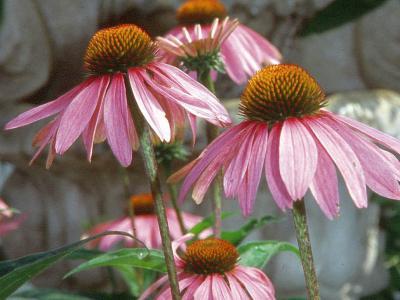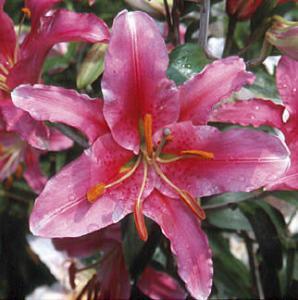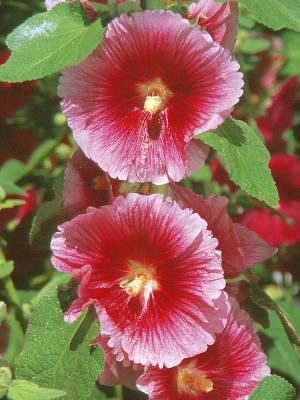By Theresa M. Forte
 | |
| Echinacea purpurea |
When the primary colour red is diluted with white, pink is the result. Red is a strong colour, known for its drama, fire and passion. Softened by a bath of white, pale red (pink) becomes a less aggressive colour; it is gently stimulating rather than fiery. Pink is the colour of love and romance. It is soothing, caring and affectionate.
In colour therapy, pink (magenta) is considered to be a nurturing and protective colour. Pink represents unconditional love. We are drawn to the maternal nature of this colour, it reflects inner strength and charm. It is the colour of compassion and love. Colour therapists suggest that pink light can help to relieve headaches and lift depression, it also is believed to help a person become focused, and perhaps, inspired.
In researching this article, I found that information on the colour pink is scarce, while studies on blue, yellow, green and red are common. I found this surprising, considering that shades and tints of pink are among the most favored in Mother Nature's own palette (second only to green). Certainly there was no difficulty in finding pink samples in my slide library, it is a very popular colour in nature. In fact, certain plants have been named to reflect this gentle colour, roses and pinks (dianthus) come to mind immediately.
|
Old garden roses such as Gallica, Damask, Zephirine Drouhin, Crested Moss and La Noblesse are coloured pink or a gentle white with a rosy blush. Their names did not need to reflect their colour, it was understood they were pink (or rose coloured). The apothecary rose (Rosa Gallica) was grown for medicinal purposes in ancient times. Dried petals were used in tonics believed to ease headaches, stress and grief. The scent of roses (and perhaps we could assume the colour rose as well) was known as a mood enhancer, it was uplifting and balancing, roses could either lift your spirits or soothe them, as required. The same positive effects can be enjoyed today, just take a stroll beneath a rose covered pergola. Bathed in gentle rose coloured light and aromatic delights, you will feel yourself relax and unwind as the walk progresses. Like most colours, pink has a number of personalities. By adding yellow or orange to pink, the warm peach tones are created. Alternately, by adding violet to pink, the cool mauve-pinks result. Both the warm and cool pinks associate well with violet blue flowers such as veronicas, perennial geraniums, lavender and salvias. The complementary colour for the blue-pinks is lime green ranging to shades of turquoise for the peach-pinks. While we may understand and use the complementary (or opposing) primary colours (such as red/green, blue/orange, or violet/yellow), it is equally important to consider this same strategy to enliven our rosy borders. In my own garden, a pretty corner bed is filled with hot pink peonies under-planted with a skirt of chartreuse lady's mantle (Alchemilla mollis). The two bloom in joyous harmony, each benefiting from its complementary companion. Similarly, Geranium 'Ann Folkard' seems to sparkle because the magenta flowers complement its lime green foliage. When looking for colours to blend with pink in a border, it is helpful to study the flower at hand and make your matches accordingly. For example, a deep pink peony with a yellow centre will marry well with like-coloured yellow companions. Similarly, Echinacea purpurea has pink petals surrounding rusty orange centres, a combination any of us might feel a little squeamish about planting ourselves and yet Mother Nature has given it her own seal of approval. We can comfortably blend similar shades in our own plans. To help with the blending process, the following plants include a hint of pink in their foliage: Panicum virgatum 'Warrior' (Red Switch Grass), a rosy glow in the flower heads from July-October; Hypericum moserianum 'Tricolor' (St. John's Wort) leaves with pink and white edging; Fagus sylvatica 'Rosea-Marginata' (Tricolor Beech) burgundy leaves with pink and white accents; Ajuga reptans 'Burgundy glow' (Carpet Bugle) variegated cream, green and rose; Salvia officinalis 'Tricolor', also in shades of pink, cream and green. To satisfy today's gardener (looking for easy care, drought tolerant garden plants) the following pink border is based on hardy roses, shrubs and low maintenance perennials that echo and complement the rosy colour scheme. This border includes Rosa Bonica, R. 'Jens Munk' and R. rugosa 'Therese Bugnet', grouped with Spirea 'Goldflame' (for the lime green foliage), S. 'Little Princess' (with pink and white flowers) and Euonymus alatus 'Compactus' (for burgundy fall colour). The bed is edged with Lavendula 'Hidcote Blue' (Lavender), Geranium sanguineum (Cranesbill), Alchemilla mollis, Salvia nemerosa 'May Night', and Ajuga reptans 'Burgundy Glow'. Miscanthus 'Morning Light' (Maiden Grass), Monarda 'Marshall's Delight' (Bee Balm), Echinacea purpurea and Malva sylvestris 'Zebrina' (reminiscent of a miniature hollyhock, blooming from July to snowfall) would be used to fill in the middle ground. With a generous planting of early spring bulbs such as grape hyacinth, early pink tulips and creamy white daffodils, the border is easy care and guaranteed to please over a long season. This pink and blue border is romantic, fragrant and perhaps most important, practical. Theresa Forte is a garden columnist, photographer and garden consultant based in Niagara Falls, Ont. Images courtesy Theresa Forte |

